Sony CRE-E10 OTC Hearing Aid Review
These budget-priced Sony hearing aids offer great Bluetooth connectivity

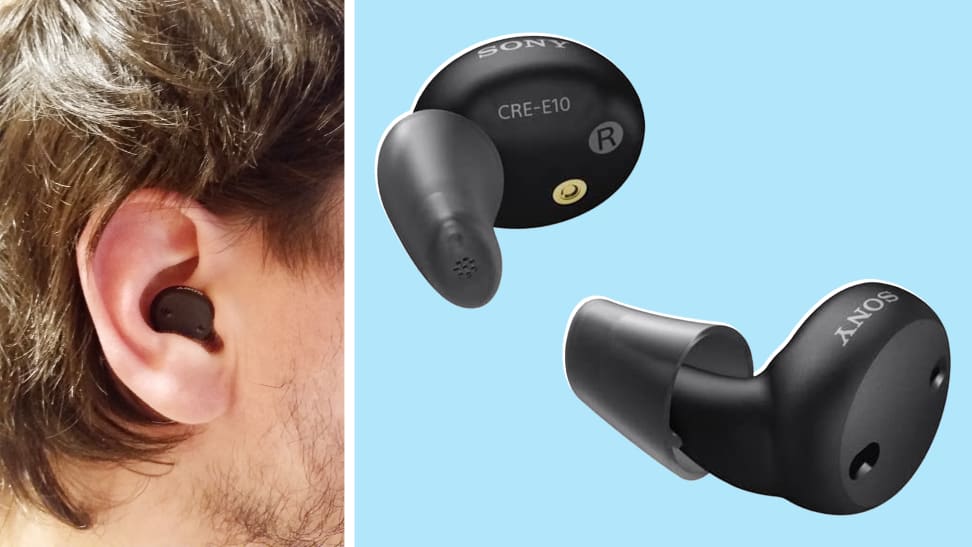 Credit:
Reviewed / Robert Rekowski / Sony
Credit:
Reviewed / Robert Rekowski / Sony
Products are chosen independently by our editors. Purchases made through our links may earn us a commission.
-

Sony CRE-E10
Pros
-
Great sound quality and fine-tuning
-
Rechargeable batteries
Cons
-
Bad out-of-box settings
-
Streaming is iOS-only
-
The direct-to-consumer hearing aid market has expanded rapidly over the last several months, and Sony has developed the CRE-C10, and the comparable CRE-E10 (available at Amazon for $799.99) , as a two-tiered entryway into the space with similar technology and FDA-cleared guidelines.
I previously reviewed the CRE-C10s, which remain a great option for those seeking hearing aids that are high-quality and affordable compared to prescription hearing aids.
The CRE-E10s are very similar and are slightly more expensive compared to that other pair. However, with the added expense comes noteworthy improvements like iOS-only Bluetooth audio streaming and rechargeable batteries. Do the benefits of the E10s outweigh the budget-friendly nature of the C10s? That’s precisely what this latest Sony hearing aid review aims to find out.
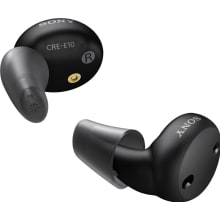
The Sony CRE-E10 hearing aids sound great and are the best pair for Bluetooth audio streaming on iOS.
About the Sony CRE-E10 hearing aids
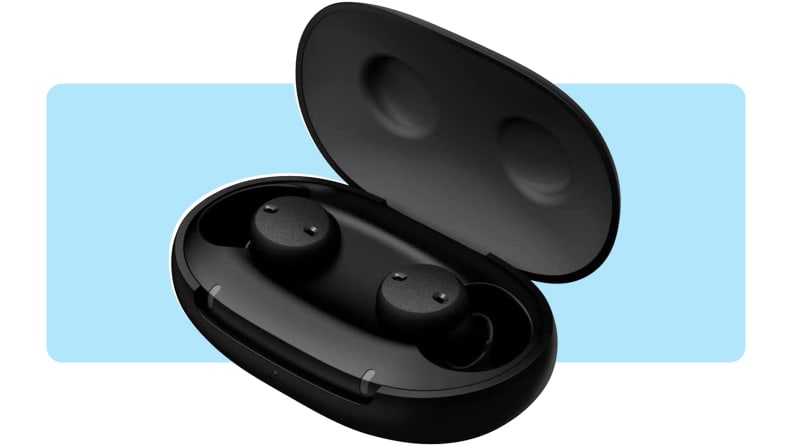
The Sony CRE-E10 storage case ensures you never run out of juice at home or on the go.
The CRE-E10 hearing aids come with both right and left hearing aids, a storage charging case, four pairs of click sleeves—extra small, small, medium, and large, with small installed by default—a USB-C charging cable, as well as a cleaning cloth and brush. I found the small sleeves worked best for me, though I typically use medium with other hearing aid products, so be sure to test all sizes to optimize your hearing-enhancement experience.
The CRE-E10s use Qi-compatible batteries for wireless charging, which promise up to 26 hours of continuous use. The batteries can also be charged using the storage case. The hearing aids come standard in black and feature an in-canal design. Though not particularly large devices, the CRE-E10s do not go entirely in the ear canal and are more visible than other significantly smaller in-the-ear-canal hearing aids I have tested.
Like the C10s, the Sony CRE-E10s connect to the Sony Hearing Control app found in the iOS App Store and Google Play. The software is easy to download and follow, and it is not cumbersome in any way for amateur users. Once installed, the app asks users to perform a hearing test, which takes about 10 minutes to complete, then it programs the hearing aids based on the results.
The app further allows users to manipulate volume, noise reduction, and treble/bass. It also has several environment-specific presets that allow the devices to narrow in on certain frequencies and speech in uncooperative, noisy environments.
What I like about the Sony CRE-E10 hearing aids
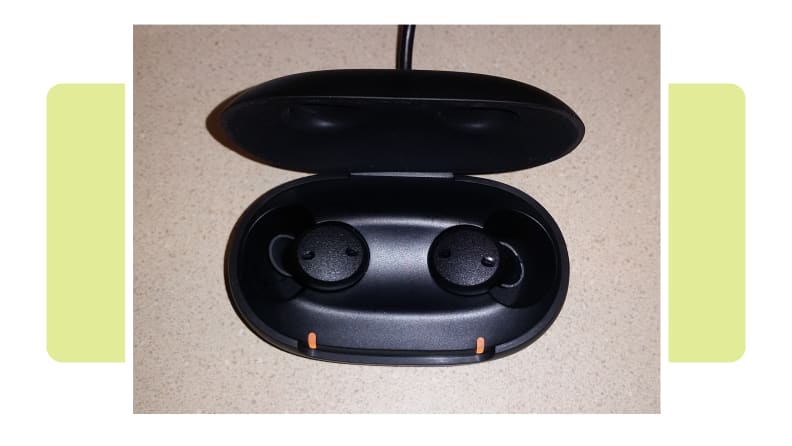
The Sony CRE-E10's batteries last a long while before they need to be recharged, and they replenish quite fast.
The app is easy to use
Despite testing several OTC products from a wide variety of hearing aid manufacturers, the Sony Hearing Control software remains one of the simplest and best-designed apps I have used. I experienced no issues downloading the app on any device or logging in and setting up an account.
Such a flawless experience is not always common. Some apps may struggle on lower-end devices. I have also tested hearing aids where the tuning app only works on either iOS or Android. Given these past shortcomings, it’s nice to have a fast, hassle-free download experience on Sony’s lineup.
Once I was able to get the hearing aids powered on, I could easily pair them with my smart device and start programming them. Once programmed, manual volume, bass/treble, and noise reduction controls are easy to adjust to fit your needs.
Sound quality and fine-tuning are impressive
Following setup through the intuitive hearing test, the CRE-E10 self-fitting hearing aids proved to be very advanced at amplifying sounds. Fine-tuning options, along with basic volume and sound balance settings, allow for a more personalized hearing experience.
When fine-tuning the hearing aids, users can select a potential weakness or issue they are detecting at any given moment, and the app offers a solution for that perceived problem. For example, if you find speech is too quiet, the app can attempt to fix that for you without altering your selected volume setting.
Or, if you find your own voice sounds nasally, the app can correct that for you under “fine-tuning" solutions. If at any point you feel you have made an error in fine-tuning the hearing aid, there is a default reset you can select to remove any unwanted changes you may have made. I really like the simplicity of the fine-tuning options that address many common problems I have experienced with other over-the-counter hearing aids.
The CRE-E10s are also equipped with automatic sound optimization, which monitors your environment and modifies its sound enhancements based on surrounding noise levels. There are also manual controls within the app, where the user can select which frequencies in the environment they want the hearing aids to narrow in on. These instant adjustments are great for conversations in areas with lots of background noise or when watching television.

The Sony CRE-E10 hearing aids sound great and are the best pair for Bluetooth audio streaming on iOS.
Rechargeable batteries add value
The Sony CRE-E10 hearing aids use rechargeable batteries with a continuous usage time of 26 hours, or 23 hours when including two full hours of streaming. So, users surrender approximately one hour of battery life for every two hours of streaming. I personally didn’t have any issue recharging my battery after a full day of use.
The batteries easily charge when the hearing aids are connected wirelessly to your storage case. The case connects to a power source or wall outlet using a standard USB-C cord or a (not included) wall adapter. The CRE-E10s are completely charged after approximately four hours when going from 0%-100%.
However, I often charge my devices each night before the power hits 0%, so charge-up times ended up being much shorter than anticipated. Many prescription hearing aids use disposable batteries, so having rechargeable batteries is a welcome upgrade that can help buyers save money in a tough economy.
High-quality streaming with no tradeoffs
The ability for the CRE-E10s to stream content using a Bluetooth connection is impressive. While there aren’t many OTC hearing aids that offer streaming features at an affordable price, the few I have tested seem to sacrifice core hearing aid features, like overall amplification quality, to make it work.
Thankfully, the Sony CRE-E10s do not have this shortcoming. Streaming sounds good, and, although it does drain the battery much faster than regular use, I like that I have the option to stream phone calls and listen to music or videos from my smart device.
What I don’t like about the Sony CRE-E10 hearing aids
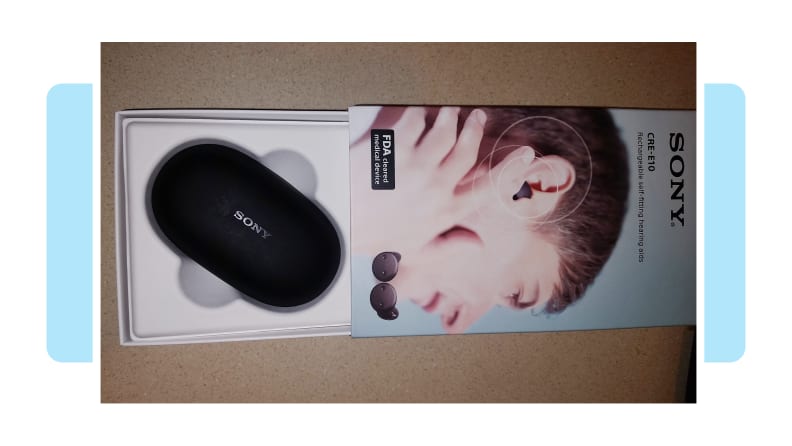
On top of taking some time to read the user manual, users should also install the Sony Hearing Control app to ensure their hearing aids are properly tuned.
Settings aren’t fit for out-of-box use
Though the setup process is not necessarily difficult, I wish the devices came with a higher volume preset out of the box. Without in-app adjustments, the CRE-E10s are not very useful in overcoming mild-to-moderate hearing loss, which is precisely what the product is marketed to do. Other devices I have tested have a somewhat satisfactory default setting that, in theory, could render the product ready to use the moment it’s unpacked.
Having a default setting that fails to provide basic relief is not a deal breaker by any means, but it is something I feel could be improved in future models. It’s disappointing when the hearing aids arrive, you place them in your ears to test them, and there is little to no immediate improvement in hearing quality.
Instead, you have to fully charge them for a few hours, find the app, connect your devices, and go through a hearing test to finally experience the impressive sound-enhancement quality the CRE-E10s offer. I think Sony would greatly benefit from having the hearing aids arrive ready to use, though I would always strongly recommend buyers connect the devices to the app and program them to best fit the individual needs of the wearer.
Powering the devices on may be buggy
While this may not be a widespread issue, there were several instances when my fully charged CRE-E10s would not power on properly after being removed from their case. It often took several attempts putting the aid back into the case and taking them out before I would receive the power-on chime. This bug continued to occur throughout testing and was not specific to one aid, meaning both right and left hearing aids had a power-on issue at one time or another.
While obvious, this intermittent flaw was not a deal breaker, and hopefully it’s an isolated incident that’s corrected in a future update. The benefit of the Sony CRE-C10s was that, as soon as the battery door was closed, the devices powered on, and I never had other issues that similar rechargeable batteries can sometimes have.
Bluetooth streaming is iOS-exclusive
As effective as the E10s use of Bluetooth technology is, it should be noted that only those with iOS devices can take advantage of it. For a longtime Android phone user like me, this limitation was obviously disappointing.
I understand the unfortunate reality of exclusivity deals in the tech sector, but, according to StatCounter, Android devices account for nearly 45% of devices in the U.S. With so many folks being excluded from accessing an otherwise great feature today, I hope future accessibility products function identically on as many devices as possible.
Should you buy the Sony CRE-E10 hearing aids?
Yes, if streaming is important to you
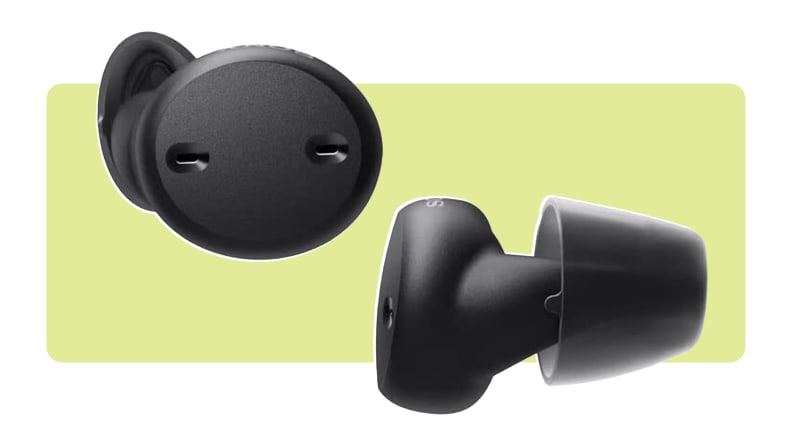
If you have a flexible budget and want to make use of modern Bluetooth features, the Sony CRE-E10 hearing aids might be for you.
These FDA-cleared hearing aids sound great and offer state-of-the-art hearing amplification for under $1,400. Though the Sony CRE-E10s have room for improvement, they function competitively in the mild-to-moderate category occupied by most other OTC hearing aids.
Not only are these hearing aids durable compared to most traditional hearing aids, but not having to buy batteries for them makes them extra easy to maintain. That fact alone could make the Sony CRE-E10s the best bang for your buck in the long run. If I were to buy these devices myself, I would not regret my purchase.
If you are on a strict budget of $1,000 and you like the more proven longevity disposable batteries offer, like I do, it may be worth buying a pair of C10 hearing aids instead. For those who are willing to spend a bit more, though, the Sony CRE-E10s are an awesome, high-end alternative for enthusiasts in search of Bluetooth-enabled hearing aids that also sound fantastic.

The Sony CRE-E10 hearing aids sound great and are the best pair for Bluetooth audio streaming on iOS.




